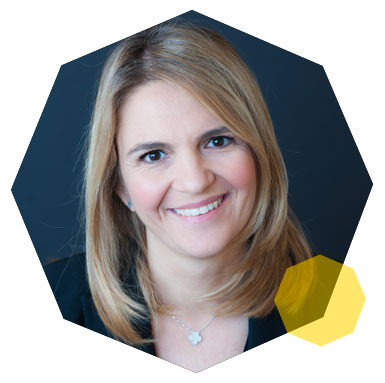
While Hedy Lamarr is best known for her roles in films like “Algiers” and “Samson and Delilah,” she was not only an actor, but also an inventor — earning both a star on the Hollywood Walk of Fame and a spot in the Inventors Hall of Fame. During World War II, Lamarr worked with film and TV composer George Antheil to develop a technology that allowed uninterrupted covert radio signals from being jammed. The groundbreaking invention, a type of frequency hopping, helped pave the way for today’s wireless communications.
As a UCLA graduate student in 1999, Danijela Cabric’s first project was to design a high-speed frequency-hopping system. The result was the fastest frequency-hopping system ever built. Now, Cabric is a professor of electrical engineering at the UCLA Samueli School of Engineering, and her work developing systems that more efficiently use the electromagnetic spectrum has continued to push the boundaries of modern radio technologies.
 Cabric appeared in the acclaimed 2017 documentary “Bombshell: The Hedy Lamarr Story,” which chronicled her exploits on the silver screen and in the lab. As part of Women’s History Month, she reflects on Lamarr’s contributions to the field and shares advice for women pursuing engineering careers.
Cabric appeared in the acclaimed 2017 documentary “Bombshell: The Hedy Lamarr Story,” which chronicled her exploits on the silver screen and in the lab. As part of Women’s History Month, she reflects on Lamarr’s contributions to the field and shares advice for women pursuing engineering careers.
How do you view Hedy Lamarr and her contributions to engineering?
Hedy’s story is empowering for women in general, and especially women in engineering. After she emigrated from Europe during World War II to pursue acting, her successful Hollywood career overshadowed her impressive engineering talent. Yet her formative work in frequency hopping is used in today’s wireless technologies including Bluetooth, Wi-Fi, GPS, the Internet of Things and many military communications systems.
I view her as an intelligent woman who loved to think and solve problems. Although she had a limited science education, she had a scientific mind and diligently worked on her inventions. Lamarr, to me, was simply unstoppable.
What do you find most interesting about her engineering talent?
I find it absolutely genius that she so easily visualized the frequency components of a radio signal and understood how radios can randomly switch frequencies to keep communications secret. To provide perspective, today’s undergraduate electrical engineering students usually learn about frequency, randomness and radio frequency tuning in their second and third years! She understood it intuitively.
She and George Anthiel were issued a patent for their work, and the methodical design drawings in their patent application are incredible, given that both were not trained engineers. But they both were creative individuals who possessed exceptional ability to grasp engineering concepts.
What can women pursuing engineering careers today learn from Lamarr’s accomplishments?
Lamarr lived in an era when Thomas Edison and Nikola Tesla were recognized inventors and women were sidelined. People found it hard to believe that her invention was her idea. She was easily dismissed. Nevertheless, she persevered and never questioned the importance of her work.
Women engineers are still a minority, and we often do not fit the stereotype of a smart, brilliant engineer, nor do we always receive credit or approval for our ideas. There are two messages that I believe are important from Hedy Lamarr’s story. First, women should consider partnering with others, both women and men, who can help them reach their goals — like Lamarr worked with George. Second, if that’s not possible, female engineers should be bold in pursuing their ideas even if they do so on their own. It’s important that we remain confident in our capabilities.
How did Lamarr’s story influence your research?
As one of the top students at the University of Belgrade in Serbia, I received a fellowship and research position at UCLA in 1999. Similar to how Lamarr came to the U.S. from Europe during a war, I emigrated from a war-torn region right before the bombing by NATO. I arrived in Los Angeles when wireless technology and the internet revolution were just beginning.
I was fascinated by wireless communications and so I joined the all-male UCLA lab that was developing wireless system prototypes. I discovered Lamarr while researching the introductory chapter of my thesis on high-speed frequency hopping. Imagine finding a glamorous female engineer who not only shared your interest, but had contributed the foundational principles of your research! I was immensely excited. As the only female in our lab, my confidence grew tremendously. Lamarr inspired me to continue pushing the boundaries of my research, and it was around that time that I started publishing papers about my work in frequency hopping.
How did your role in the “Bombshell” documentary come about?
In 2016, one of the producers called me and I was momentarily floored by one of his first questions: “Do you know anything about Hedy Lamarr?” By the end of our conversation he asked if I would like to be interviewed for a documentary about her. Of course, I agreed. In the film I play myself — an expert in secure communications! My participation also allowed me to represent women in engineering. It was a wonderful experience, and I hope everyone gets to watch the documentary and see Lamarr’s fascinating story unfold.
What do you hope people will learn from her story?
I believe a central factor that limits more women and underrepresented minorities from pursuing an engineering education or career is the stereotypical image of who an engineer is. Hedy Lamarr’s story provides a powerful message to not be bound by stereotypes, your own preconceptions of who you are or others’ ideas of who you should be. Always follow your passion, seek out a mentor you connect with and never give up.
IMAGES BY
From “Bombshell” – image used for non-commercial, explanatory purposes only.
hedylammar.com– image used for non-commercial, explanatory purposes only.
